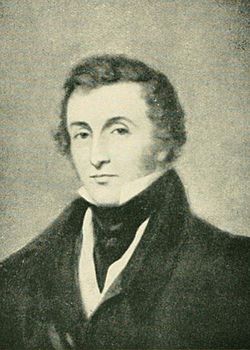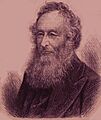Sir William Jardine, 7th Baronet facts for kids
Quick facts for kids
Sir William Jardine, 7th Baronet
|
|
|---|---|

Portrait, c. 1822
|
|
| Born | 23 February 1800 Edinburgh, Scotland
|
| Died | 21 November 1874 (aged 74) Sandown, Isle of Wight, England
|
| Alma mater | Edinburgh University |
| Known for | Natural history |
Sir William Jardine (born February 23, 1800 – died November 21, 1874) was a Scottish naturalist. He was very important for making natural history popular. He is best known for editing a huge series of books called The Naturalist's Library.
Contents
Who Was Sir William Jardine?
Sir William Jardine was born in Edinburgh, Scotland, on February 23, 1800. His father was Sir Alexander Jardine. William studied medicine at Edinburgh University.
Early Life and Education
From 1817 to 1821, he lived with a minister named Rev Dr Andrew Grant. This was arranged by his father. William was very smart and interested in science from a young age.
Becoming a Naturalist
When he was only 25, Jardine became a member of the Royal Society of Edinburgh. This is a very respected group for scientists. He also helped start the Berwickshire Naturalists' Club. He was very good at outdoor activities like fishing and hunting.
Jardine's Scientific Work
Sir William Jardine loved studying nature. While birds were his main interest, he also studied fish, plants, and rocks. He had one of the best private natural history museums and libraries in Britain.
Studying Fossils and Ancient Traces
Jardine wrote a book about fossil burrows and traces. These are marks left by ancient animals. The book was called Ichnology of Annandale. He even found fossils on his family's land. He was the first person to use the word ichnology for this study.
Making Natural History Popular
Jardine wanted everyone to learn about nature. He edited a very popular series of 40 books. It was called The Naturalist's Library (1833–1843). His brother-in-law, William Home Lizars, published the books.
What Was in The Naturalist's Library?
The book series had four main parts:
- Ornithology: This section was about birds (14 volumes).
- Mammalia: This part covered mammals (13 volumes).
- Entomology: This section focused on insects (7 volumes).
- Ichthyology: This part was about fish (6 volumes).
Leading naturalists wrote each section. Famous artists like Edward Lear drew the pictures.
Other Important Books
Jardine also published other important works. He edited Gilbert White's Natural History of Selborne. This book helped make White famous again. He also published Illustrations of Ornithology (1825–1843). Another work was an affordable version of Alexander Wilson's Birds of America.
Discovering New Bird Species
Jardine described many new bird species. He often worked with his friend Prideaux John Selby. Sir William Jardine passed away on November 21, 1874, on the Isle of Wight.
Jardine's Family
Sir William Jardine was married to Jane Home Lizars. After she passed away, he married the daughter of Rev. William Samuel Symonds.
Family Contributions to Science
Jardine's daughter, Catherine Dorcas Maule Jardine, was also talented. She married Hugh Edwin Strickland. Catherine drew many of the illustrations for her father's book, Illustrations of Ornithology. You can often see her initials, CDMS, on her drawings.
Famous Descendants
A famous Olympic rower, Sir Matthew Pinsent, is a direct descendant of Sir William Jardine.
Images for kids
See also
- Jardine baronets



